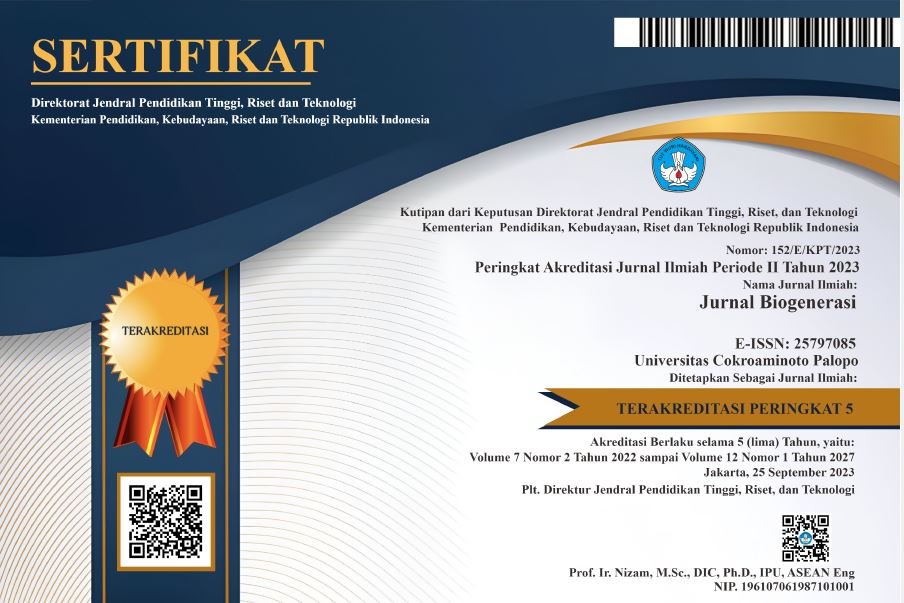Potensi Tanaman Iris Air (Iris pseudacorus) sebagai Agen Bioremediasi pada Limbah Air Rumah Tangga di Laut Dendang
DOI:
https://doi.org/10.30605/biogenerasi.v9i2.4770Keywords:
Bioremediation, Iris pseudacorus, household wastewater, water quality, phytoremediationAbstract
This research evaluates the potential of Iris pseudacorus as a bioremediation agent toreduce household wastewater pollution. Using an experimental approach, wastewater samples with different concentrations (1200 ml, 1000 ml, 700 ml, and 500 ml) were tested with Iris water for 10 days. Parameters such as pH, TDS, temperature, turbidity, and odor were observed periodically. Results showed that Iris pseudacorus effectively increased pH, reduced odor, and removed turbidity, and maintained TDS stability, indicating the ability of this plant to absorb pollutants and improve wastewater quality. This study concludes that Iris pseudacorus has strong potential as a bioremediation agent to improve water quality and support environmental sustainability.
Downloads
References
Aneta, R., Umboh, J. M. L., dan Sodankh, R. C. (2021). ANALISIS TINGKAT KEKERUHAN, TOTAL DISSOLVED SOLIDS (TDS) DAN KANDUNGAN Escherichia COLI PADA AIR SUMUR DI DESA ARAKAN KECAMATAN TATAPAAN. Jurnal KESMAS, 10(4); 106-111
Ariyadih. et.al. (2017). Deskripsi Dan identifikasi Tumbuhan Iris kuning. Malang : Universitas Negeri Malang
Arni, A., & Susilawati, S. (2022). Pencemaran air sungai akibat pembuangan sampah di desa bagan kuala tanjung beringin Kabupaten Serdang Bedagai. Nautical: Jurnal Ilmiah Multidisiplin Indonesia, 1(4), 241-245.
Atmaja. (2022). Fitoremediai Air Limbah Laundry dengan Tanaman Kana (Canna indica) Pada Constructed wetland. Jambi: Universitas Batanghari
Ayuningtyas et.al. (2023). PENGOLAHAN LIMBAH DOMESTIK SECARA FITOREMEDIASI SISTEM CONSTRUCTED WETLANDS DENGAN TANAMAN HIAS IRIS (Iris pseuadacorus) DAN MELATI AIR (Echinodorus palifolius). Jurnal Rekayasa Lingkungan : 23 (2).80-87
Ayuningtyas, E., Muyasaroh, N., Hermawan, H. B., AS, I. A., Susetyaningsih, R., & KR, M. N. (2023). PENGOLAHAN LIMBAH DOMESTIK SECARA FITOREMEDIASI SISTEM CONSTRUCTED WETLANDS DENGAN TANAMAN HIAS IRIS (Iris pseuadacorus) DAN MELATI AIR (Echinodorus palifolius). Jurnal Rekayasa Lingkungan, 23(2), 80-87.
Dewi, E. R. S., Nurwahyunani, A., Sari, E. L., Nissa, F. K., AlfinaSeptiana, M., Andriani, D. R., & Azuhro, V. (2024). TEKNIK BIOREMEDIASI SEBAGAI SOLUSI DALAM UPAYA PENGENDALIAN PENCEMARAN LINGKUNGAN: LITERATUR REVIEW. HUMANITIS: Jurnal Homaniora, Sosial dan Bisnis, 2(1), 124-135.
E. Suryati, H. Triana, U. Widyastuti, A. Tenriulo. (2016). Regenerasi dan Perbanyakan Rumput Laut Kappaphycus alvarezii Hasil Transformasi Gen Superoksida Dismutase (MaSOD). Jurnal Riset Akuakultur, 11(129), 321–330.
Elmiyyah. (2022). EFEKTIVITAS FITOREMEDIASI Iris pseudacorus DALAM MENURUNKAN KADAR BOD, COD, DAN WARNA PADA LIMBAH CAIR BATIK TULIS LASEM REMBANG. Semarang : UNIVERSITAS ISLAM NEGERI WALISONGO
Elmiyyah. (2022). EFEKTIVITAS FITOREMEDIASI Iris pseudacorus DALAM MENURUNKAN KADAR BOD, COD, DAN WARNA PADA LIMBAH CAIR BATIK TULIS LASEM REMBANG. Semarang : Universitas Islam Negeri Wali Songo.
Ghiovanni et.al. (2017). Fitoremediasi Air yang Tercemar Limbah Laundry dengan Menggunakan Kayu apu (Pistia stratiotes). Jurnal Teknis ITS: 6 (2). 232-236
Kuswoyo, A., & Ulimaz, A. (2022). Pengaruh Jenis dan Ketebalan Karbon Aktif pada Sistem Constructed Wetlands untuk Pengolahan Limbah Cair Rumah Tangga. Bioscientist: Jurnal Ilmiah Biologi, 10(1), 173-181.
Mangkoedihardjo S, Ganjar S. (2010). Fitoteknologi Terapan. Yogyakarta: Graha Ilmu.
Nainggolan Y. D., Sugiyani, T., Nababan, J., Simbolon, W., dan Hermayantiningsih D. (2024). ANALISA PENGARUH SUHU, PH DAN TDS TERHADAP KUALITAS AIR DI SUNGAI KAHAYAN KALIMANTAN TENGAH. Prosiding Seminar Nasional Sains dan Teknologi Seri 02, 1(2); 913-919.
Nila, Sari. 2013. Fitoremediasi Limbah Rumah Tangga oleh Tanaman Wilingen (Scripus grossus), Kiapu (Pistia stratiotes) dan Teratai (Nymphea firecrest). Jurnal Lingkungan, Vol.5, No.2, p.67-90
Ningsih. (2017). UJI PENURUNAN KANDUNGAN BOD,COD, DAN WARNA PADA LIMBAH CAIR PEWARNAAN BATIK MENGGUNAKAN Scirpus grossus DAN Iris pseudacorus DENGAN SISTEM PEMAPARAN INTERMITTENT. Surabaya: Institut Teknologi Sepuluh November
Sa’adah, dan S. Widyaningsih. (2018). Pengaruh Pemberian CO2 terhadap pH Air pada Pertumbuhan Caulerpa racemosa var. uvifera, Jurnal Kelautan Tropis, 21(1), 17–22.
Sari, M., dan Huljana, M. (2019). Analisis Bau, Warna, TDS, pH, dan Salinitas Air Sumur Gali di Tempat Pembuangan Akhir. Jurnal Ilmu Kimia dan Terapan, 3(1); 1-5.
Sugiyono. (2018). Metode Penelitian Kuantitatif, Kualitatif, dan R&D. Bandung: Alfabeta. Google Scholar
Wulandari. Et.al. (2013). PEMANFAATAN TUMBUHAN IRIS AIR (Neomarica gracillis) SEBAGAI AGEN BIOREMEDIASI AIR LIMBAH RUMAH TANGGA. Jurnal UNS: 10 (3). 1-6
Downloads
Published
How to Cite
Issue
Section
License
In submitting the manuscript to the journal, the authors certify that:
- They are authorized by their co-authors to enter into these arrangements.
- The work described has not been formally published before, except in the form of an abstract or as part of a published lecture, review, thesis, or overlay journal.
- That it is not under consideration for publication elsewhere,
- That its publication has been approved by all the author(s) and by the responsible authorities – tacitly or explicitly – of the institutes where the work has been carried out.
- They secure the right to reproduce any material that has already been published or copyrighted elsewhere.
- They agree to the following license and copyright agreement.
License and Copyright Agreement
Authors who publish with this journal agree to the following terms:
- Authors retain copyright and grant the journal right of first publication with the work simultaneously licensed under Creative Commons Attribution License (CC BY 4.0) that allows others to share the work with an acknowledgment of the work's authorship and initial publication in this journal.
- Authors are able to enter into separate, additional contractual arrangements for the non-exclusive distribution of the journal's published version of the work (e.g., post it to an institutional repository or publish it in a book), with an acknowledgment of its initial publication in this journal.
- Authors are permitted and encouraged to post their work online (e.g., in institutional repositories or on their website) prior to and during the submission process, as it can lead to productive exchanges, as well as earlier and greater citation of published work.


.png)

